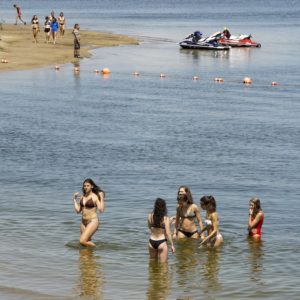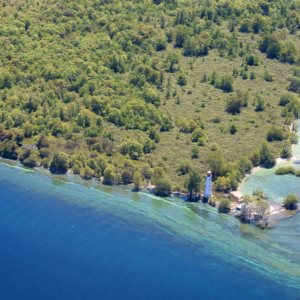Do Canadians want protected ‘National Mining Areas’ instead of National Wildlife Areas?
 On Friday, October 29th, the federal government made an unexpected decision to permit mineral exploration in a highly anticipated protected area in the NWT. The 14,250 km-squared area west of Great Slave Lake is called Edéhzhíe (Horn Plateau) and is slated to soon become a National Wildlife Area (NWA). Perhaps the federal government instead wishes to designate a protected National Mining Area…
On Friday, October 29th, the federal government made an unexpected decision to permit mineral exploration in a highly anticipated protected area in the NWT. The 14,250 km-squared area west of Great Slave Lake is called Edéhzhíe (Horn Plateau) and is slated to soon become a National Wildlife Area (NWA). Perhaps the federal government instead wishes to designate a protected National Mining Area…
Edéhzhíe is both culturally and ecologically significant for the Dehcho and Tłįcho peoples, and is enshrined in Dene tradition and spirituality. The Horn Plateau is an important wetland stop-over along the Central and Mississippi migratory flyways, and is not surprisingly home to the Mills Lake Important Bird Area (IBA), known for globally significant numbers of Tundra Swan and other waterfowl, and continentally significant numbers of Greater White-fronted Goose. Edéhzhíe also provides habitats for several ‘at-risk’ species including boreal woodland caribou, wood bison and wolverine. It is known as a “food basket” in times of need within surrounding Mackenzie Valley communities.
Despite its rich natural and cultural heritage, Friday’s decision marks a significant policy reversal – one that opens up Edéhzhíe’s subsurface to mining and oil & gas industry interests. This ultimately poses a threat to the ecological integrity of important lakes and wetlands and boreal forest habitats in this region.
This surprising decision overturns a formal request by the Grand Chiefs of the Dehcho First Nation and Tłįchǫ Government that Environment Minister Jim Prentice designate the Edéhzhíe NWA and permanently protect the subsurface lands beneath it. Friday’s decision also ignores recommendations for the same surface/subsurface protections made in a 2009 report by the Edéhzhíe Candidate Protected Area Working Group. That Working Group consulted widely with stakeholders on options for the area, as part of the multi-stakeholder NWT Protected Areas Strategy. The 2009 report was submitted to the Dehcho First Nation, the Tłįchǫ Government and Environment Canada, the federal department responsible for establishing and overseeing NWAs.
Nature Canada is very disappointed with the federal government’s decision on Edéhzhíe, which was made just two days before interim government protections on both the surface and subsurface lands of Edéhzhíe were about to expire – after more than a decade of being retained.
The decision was recommended by Minister John Duncan of Indian and Northern Affairs Canada (INAC; PC number 2010-1360), the federal department holding significant jurisdiction over resource management and social and economic development north of 60°. It should be noted that Minister Duncan’s decision on Edéhzhíe was made indirectly: he recommended that only surface land withdrawals be ‘renewed’ for the area, instead of rights to both surface and subsurface lands. It’s easy to get lost in the details.
It’s worth noting here that in 2009 the Edéhzhíe Working Group  recommended a final boundary for the NWA that was 57% of the original 25,000 km-squared study area. The excluded portions represent most of the areas of significant lead/zinc and gas potential within the study area. A 2009 mining industry newsletter laments that even this reduced boundary is too restrictive and prevents the industry from understanding the “true resource potential” of the area, particularly that of diamonds. Interestingly, the 2008 socio-economic assessment of the Edéhzhíe Candidate Protected Area, done by AMEC consultants for INAC, suggests it would be 10-20 years before any non-renewable resource developments could be operational in the area.
recommended a final boundary for the NWA that was 57% of the original 25,000 km-squared study area. The excluded portions represent most of the areas of significant lead/zinc and gas potential within the study area. A 2009 mining industry newsletter laments that even this reduced boundary is too restrictive and prevents the industry from understanding the “true resource potential” of the area, particularly that of diamonds. Interestingly, the 2008 socio-economic assessment of the Edéhzhíe Candidate Protected Area, done by AMEC consultants for INAC, suggests it would be 10-20 years before any non-renewable resource developments could be operational in the area.
Nature Canada’s disappointment in the government’s Edéhzhíe decision stems from three points:
First, there are clear legislative options to protect both the surface and subsurface lands of Edéhzhíe through an NWA designation combined with an Order in Council (under the Territorial Lands Act). This is what many conservation groups and the Dehcho First Nation and Tłįchǫ Government want. The Canada Wildlife Act gives the Minister of Environment authority to establish and manage NWAs across Canada, but does not protect subsurface lands beneath those NWAs. This is a serious weakness of the Act and currently makes NWAs the ‘poor cousins’ of more strictly protected areas like National Parks. Minister Duncan’s inaction with respect to protecting Edéhzhíe’s subsurface suggests that INAC is not willing to support options that respect the wishes of key stakeholders. More importantly, this surprising situation suggests that INAC is not comfortable communicating its true intent to stakeholders of the Edéhzhíe NWA.
Second, this decision has very serious implications for the entire network of 54 NWAs across Canada. This is the first time the federal government has ‘opened’ a proposed or existing NWA to industrial development. It sends a clear message that NWAs are not off-limits to subsurface resource extraction, regardless of what local stakeholders, First Nations governments and Canadians say about how these areas should be managed and safeguarded over time. While Nature Canada awaits the federal government’s final decision on Cenovus’s proposal to drill 1,275 gas wells inside the CFB Suffield NWA, we are dismayed that the writing may already be on the wall. This is even more concerning given the presence of nationally endangered species in the grasslands of Suffield NWA. Friday’s decision also raises important questions about national parks that are potentially threatened by resource extraction within or just beyond their borders, such as the recently announced Sable Island National Park or the proposed Nááts’ihch’oh National Park Reserve.
Third, we expected the federal government to respect the wishes of First Nations governments and the 2009 recommendations of the Edéhzhíe Working Group. We now question the government’s commitment to listen to First Nations and Aboriginal organizations and other stakeholders during future NWA designations through the NWT Protected Areas Strategy. This is particularly worrisome given that local communities in the NWT have shown support for subsurface protection in other candidate NWAs.
 While Friday’s decision opens the Horn Plateau’s subsurface to mining activity, interim protections on Edéhzhíe’s surface lands have been renewed until October 31, 2012.
While Friday’s decision opens the Horn Plateau’s subsurface to mining activity, interim protections on Edéhzhíe’s surface lands have been renewed until October 31, 2012.
Please check back to follow Nature Canada’s unfolding response to this story. The NWT Protected Area Strategy hosts an on-line album of Edéhzhíe photos you can view here.
Photo 1: Mackenzie Valley, Jeff Wells
Photo 2: Boreal Chickadee, Jeff Nadler
Photo 3: Migrating Snow Geese, Stewart Marshall, Flickr


